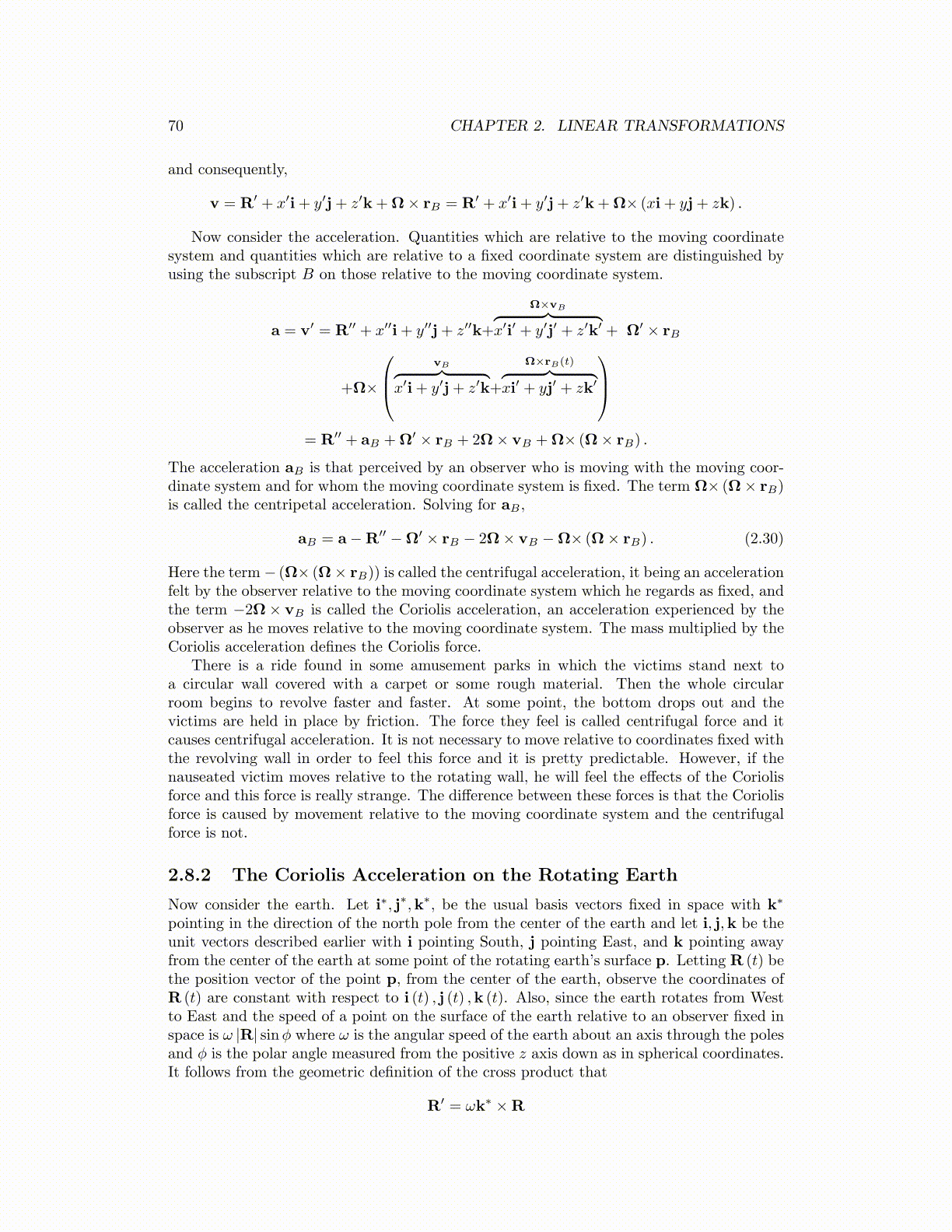
70 CHAPTER 2. LINEAR TRANSFORMATIONS
and consequently,
v = R′ + x′i+ y′j+ z′k+Ω× rB = R′ + x′i+ y′j+ z′k+Ω× (xi+ yj+ zk) .
Now consider the acceleration. Quantities which are relative to the moving coordinatesystem and quantities which are relative to a fixed coordinate system are distinguished byusing the subscript B on those relative to the moving coordinate system.
a = v′ = R′′ + x′′i+ y′′j+ z′′k+
Ω×vB︷ ︸︸ ︷x′i′ + y′j′ + z′k′ + Ω′ × rB
+Ω×
vB︷ ︸︸ ︷x′i+ y′j+ z′k+
Ω×rB(t)︷ ︸︸ ︷xi′ + yj′ + zk′
= R′′ + aB +Ω′ × rB + 2Ω× vB +Ω× (Ω× rB) .
The acceleration aB is that perceived by an observer who is moving with the moving coor-dinate system and for whom the moving coordinate system is fixed. The term Ω× (Ω× rB)is called the centripetal acceleration. Solving for aB ,
aB = a−R′′ −Ω′ × rB − 2Ω× vB −Ω× (Ω× rB) . (2.30)
Here the term − (Ω× (Ω× rB)) is called the centrifugal acceleration, it being an accelerationfelt by the observer relative to the moving coordinate system which he regards as fixed, andthe term −2Ω× vB is called the Coriolis acceleration, an acceleration experienced by theobserver as he moves relative to the moving coordinate system. The mass multiplied by theCoriolis acceleration defines the Coriolis force.
There is a ride found in some amusement parks in which the victims stand next toa circular wall covered with a carpet or some rough material. Then the whole circularroom begins to revolve faster and faster. At some point, the bottom drops out and thevictims are held in place by friction. The force they feel is called centrifugal force and itcauses centrifugal acceleration. It is not necessary to move relative to coordinates fixed withthe revolving wall in order to feel this force and it is pretty predictable. However, if thenauseated victim moves relative to the rotating wall, he will feel the effects of the Coriolisforce and this force is really strange. The difference between these forces is that the Coriolisforce is caused by movement relative to the moving coordinate system and the centrifugalforce is not.
2.8.2 The Coriolis Acceleration on the Rotating Earth
Now consider the earth. Let i∗, j∗,k∗, be the usual basis vectors fixed in space with k∗
pointing in the direction of the north pole from the center of the earth and let i, j,k be theunit vectors described earlier with i pointing South, j pointing East, and k pointing awayfrom the center of the earth at some point of the rotating earth’s surface p. Letting R (t) bethe position vector of the point p, from the center of the earth, observe the coordinates ofR (t) are constant with respect to i (t) , j (t) ,k (t). Also, since the earth rotates from Westto East and the speed of a point on the surface of the earth relative to an observer fixed inspace is ω |R| sinϕ where ω is the angular speed of the earth about an axis through the polesand ϕ is the polar angle measured from the positive z axis down as in spherical coordinates.It follows from the geometric definition of the cross product that
R′ = ωk∗ ×R